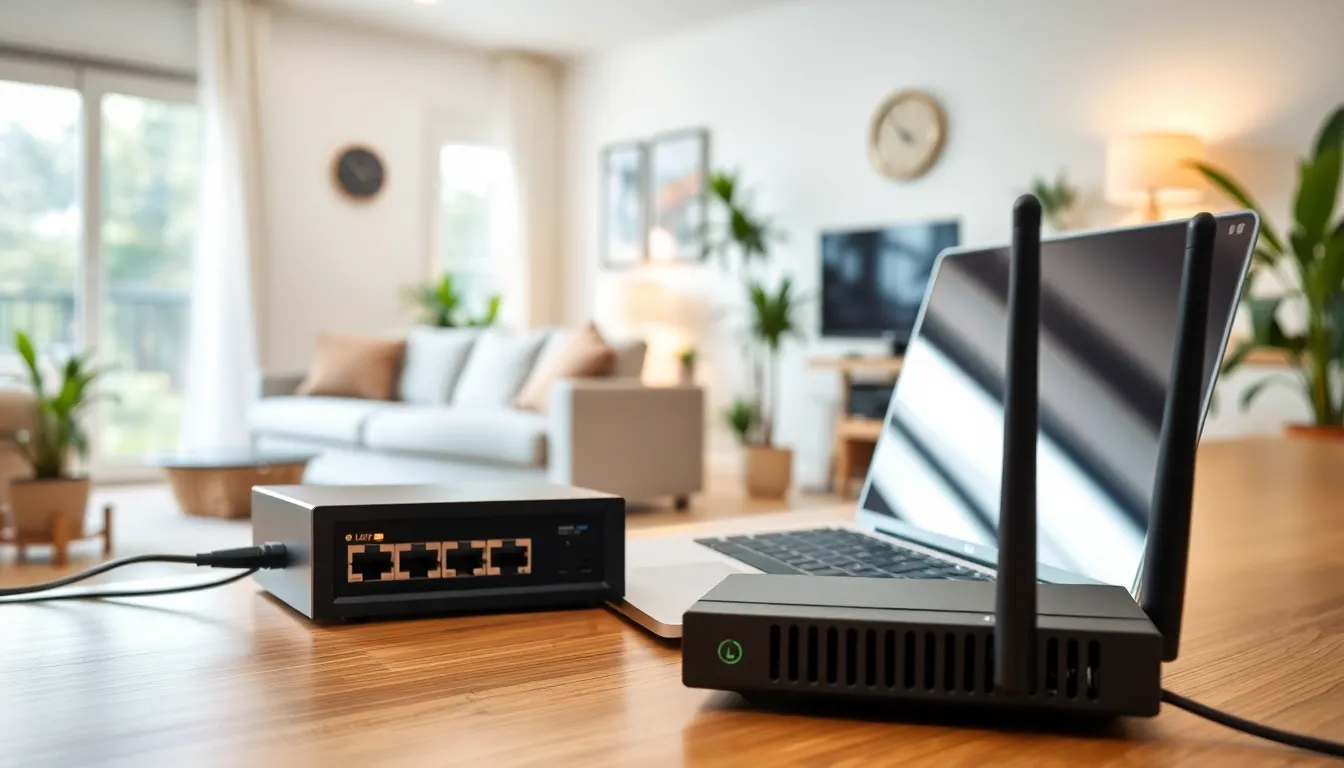In today’s digital age, a reliable home network isn’t just a luxury; it’s a necessity. Picture this: you’re streaming your favorite show, and suddenly the Wi-Fi drops. Cue the panic! A solid home networking service can save you from those cringe-worthy moments. It keeps your devices connected, your online gaming lag-free, and your video calls crystal clear.
Table of Contents
ToggleUnderstanding Home Networking Service
Home networking service encompasses the technologies and solutions that facilitate connectivity within a household. Individuals rely on these services for various online activities, creating a need for effective networking solutions.
What Is Home Networking Service?
Home networking service refers to the setup and management of devices that connect to the internet within a home. It includes routers, switches, access points, and network extenders. These components work together to provide consistent internet access throughout the space. A well-configured home network supports smart devices, computers, and mobile gadgets, enabling seamless interaction between them.
Benefits of Home Networking Service
Enjoying seamless connectivity tops the list of benefits associated with home networking services. Improved bandwidth ensures multiple users can stream, game, and browse simultaneously without interruptions. Enhanced security features protect sensitive personal information from unauthorized access. Faster data transfer speeds enable quick downloads and efficient file sharing between devices. Easy expansion options allow homeowners to scale their networks as needed, accommodating new devices and technologies. Overall, these advantages cultivate a more connected and efficient digital lifestyle.
Types of Home Networking Services

Several types of home networking services exist, each designed to cater to specific connectivity needs. Understanding these options can enhance choices when setting up a home network.
Wired Networking Services
Wired networking services utilize physical cables to connect devices. Ethernet cables connect computers, printers, and other equipment directly to a router or switch. This method ensures stable and fast connections, making it ideal for activities requiring high bandwidth, such as online gaming or video streaming. Common wiring types include Cat5e, Cat6, and Cat7 cables. Each type supports different speeds and bandwidths, with Cat6 offering better performance for most home users. Wired networks also provide added security and reduced interference compared to wireless options.
Wireless Networking Services
Wireless networking services provide connectivity without cable reliance. Wi-Fi technology allows devices to connect to the internet via routers equipped with antennas. Users benefit from mobility, as they can access the network from various rooms or outdoor spaces within their home. Various standards, such as Wi-Fi 5 and Wi-Fi 6, offer different speeds and capacities, with Wi-Fi 6 significantly improving efficiency for multiple devices. Wireless access points and extenders enhance coverage, reducing dead zones in larger homes. Security protocols like WPA3 ensure safe connections, protecting personal information from unauthorized access.
Choosing the Right Home Networking Service
Selecting a suitable home networking service enhances online experiences significantly. Essential considerations include speed, reliability, coverage, and security features.
Factors to Consider
Speed serves as a key factor in choosing a networking service. It impacts streaming, gaming, and working from home. Reliability ensures consistent connections across all devices. Coverage becomes important when multiple rooms require access. Evaluate the number of connected devices a household uses simultaneously. Security protocols, such as WPA3, protect personal information from unauthorized access. Compatibility with existing devices is crucial for seamless integration. Budget also plays a role. Quality services often come with a higher price, but oftentimes, they provide better support and features.
Popular Providers
Several providers dominate the home networking service landscape. Xfinity offers a variety of plans tailored to different needs and budgets. AT&T boasts extensive fiber options, delivering high-speed internet access. Verizon provides reliable service with competitive pricing and versatile packages. Google Fiber offers straightforward pricing with impressive speeds in select areas. Spectrum combines flexibility with wide coverage. Each provider represents unique features and pricing structures. Doing research helps users find the best fit for their specific requirements. Prioritizing essential needs simplifies the selection process significantly.
Setting Up Your Home Networking Service
Establishing a dependable home networking service requires careful planning and execution. Following structured steps can ensure a reliable setup.
Installation Steps
First, choose the right location for the router. Central placement minimizes dead zones. Next, connect the modem to the router using an Ethernet cable. After this, power on both devices and wait for them to initialize. Access the router’s setup page using a web browser and follow the on-screen instructions to configure the network. Set a strong password and enable WPA3 for enhanced security. Finally, connect devices to the network, ensuring each one can access the internet reliably.
Common Challenges
Users often face challenges during setup. One common issue involves connectivity problems, which can stem from interference caused by walls or electronic devices. Additionally, forgetting the router’s password can lead to frustration, requiring a reset to regain access. Network coverage might not reach distant rooms, necessitating the use of extenders or additional access points. Many encounter difficulties configuring advanced settings, underscoring the importance of consulting the user manual or online resources for guidance. Addressing these challenges promptly ensures a smoother networking experience.
Investing in a reliable home networking service is crucial for anyone looking to enhance their digital lifestyle. With the right setup and components, users can enjoy seamless connectivity and improved performance across all devices. As technology continues to evolve, understanding the various options available empowers individuals to make informed decisions tailored to their specific needs.
By prioritizing speed, reliability, and security, homeowners can create a robust network that supports everything from streaming to remote work. Whether opting for wired or wireless solutions, careful planning and execution can lead to a more efficient and enjoyable online experience. Embracing these networking solutions will ensure that households remain connected in an increasingly digital world.








